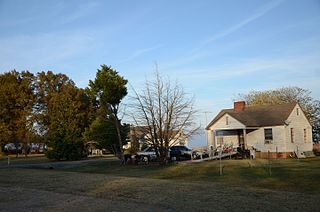
Jefferson County, Arkansas is a county located in the U.S. state of Arkansas in the area known as the Arkansas Delta that extends west of the Mississippi River. Jefferson County consists of five cities, two towns, and 20 townships. It is bisected by the Arkansas River, which was critical to its development and long the chief transportation byway. In 2020, Jefferson County's population was estimated at 67,260. The county seat and largest city is Pine Bluff. The county is included in the Pine Bluff metropolitan statistical area. The county seat and the most populous city is Pine Bluff.

Pine Bluff is the 10th most populous city in the US state of Arkansas and the county seat of Jefferson County. It is the principal city of the Pine Bluff Metropolitan Statistical Area and part of the Little Rock-North Little Rock-Pine Bluff Combined Statistical Area. The population of the city was 41,253 in the 2020 census.

For people with the surname, see Redfield (surname).

Sherrill is a town in Plum Bayou Township, Jefferson County, Arkansas, United States. Its population was 84 at the 2010 U.S. census. It is included in the Pine Bluff, Arkansas Metropolitan Statistical Area.

Wabbaseka is a town in Dunnington Township, Jefferson County, Arkansas, United States. Its population was 255 at the 2010 U.S. census. It is included in the Pine Bluff, Arkansas Metropolitan Statistical Area.
Pine Bluff High School (PBHS) is a comprehensive public high school in Pine Bluff, Arkansas, United States. It, a part of the Pine Bluff School District, is the largest of three public high schools in the Pine Bluff city limits and four public high schools in Jefferson County. Established in 1868, the school's interscholastic sports programs are one of the nation's most successful with a football national championship and one of the state's highest number of state championships in football, baseball and track and field.
Pine Bluff School District No. 3 (PBSD) is a school district headquartered in Pine Bluff, Arkansas. The district has 10 schools with over 3,800 students and 500 employees.
White Hall School District (WHSD) is a public school district in northwest Jefferson County, Arkansas, United States. The district employs approximately 400 faculty members and staff to provide educational programs for students ranging from kindergarten through twelve grade. It currently serves more than 3,000 students. All schools in the White Hall School District are accredited by AdvancED.
Dollarway School District No. 2 (DSD) was a school district headquartered in Pine Bluff, Arkansas, United States. With over 1,600 students and employing more than 300 educators and staff, the district had three active school campuses at the end of its life.

Lake Dick is an unincorporated community in Jefferson County, Arkansas, United States. Lake Dick is northeast of Pine Bluff and south of Altheimer.

Tucker is an Unincorporated community and census-designated place (CDP) in Jefferson County, Arkansas. It is located 30 miles (48 km) southeast of Little Rock. It was first listed as a CDP in the 2020 census with a population of 95.
Wright is an unincorporated community in Jefferson County, Arkansas, United States. Wright is located on Arkansas Highway 256, 7.5 miles (12.1 km) west-northwest of Sherrill. Wright has a post office with ZIP code 72182.
New Gascony, also known as Barraqué Landing, is an unincorporated community in Jefferson county, Arkansas, 13 miles (21 km) west of Pine Bluff, the county seat. It was founded by Antoine Barraqué, a 19th-century landowner, on November 29, 1832, and named for the Gascony region of France.
Sweden is an unincorporated community in Jefferson County, Arkansas, United States. Sweden is located on Arkansas Highway 88, 16.1 miles (25.9 km) east of Pine Bluff. On January 22, 2012, an EF2 tornado struck Sweden, damaging grain bins and metal buildings; the tornado continued to a point northeast of Lodge Corner in Arkansas County.
Dollarway High School was a comprehensive public high school in northwest Pine Bluff, Arkansas that serves grades 9 through 12. It was one of three public high schools in Pine Bluff and was a part of the Pine Bluff School District effective July 1, 2021. Prior to that point it was the only high school managed by the Dollarway School District. Within the state, the school is often referred to as Pine Bluff Dollarway. It closed as of fall 2023.
Altheimer Unified School District No. 22, previously the Altheimer-Sherrill School District, was a school district headquartered in Altheimer, Arkansas. It served Altheimer, Sherrill, Wabbaseka, and other portions of Jefferson County, including the unincorporated areas of Lake Dick, New Gascony, Pastoria, Plum Bayou, Sweden, Tucker, and Wright. The district in the 1993-2006 period had 333 square miles (860 km2) of territory.
Altheimer-Sherrill High School was a junior and senior high school in Altheimer, Arkansas, United States, operated by the Altheimer-Sherrill School District, and later the Altheimer Unified School District. At the time of its closing it served Altheimer, Sherrill, Wabbaseka, and other portions of Jefferson County, including the unincorporated areas of Tucker, Plum Bayou, Pastoria, and Wright.
Wabbaseka-Tucker School District, previously the Wabbaseka School District No. 7, was a school district in Jefferson County, Arkansas, serving Wabbaseka, Tucker, and Plum Bayou.
Pastoria, also known as Pastoria Township, in an unincorporated community in Jefferson County, Arkansas. It lost population to Sherrill, Arkansas after a rail line bypassed it in the 19th century.
Hardin is an unincorporated area in Washington Township, Jefferson County, Arkansas.









